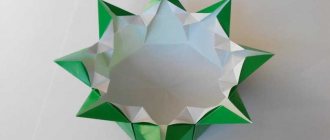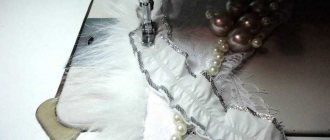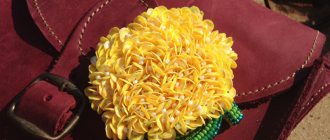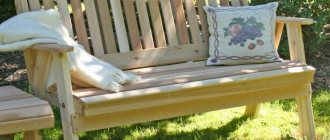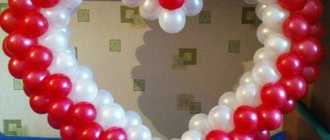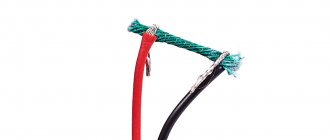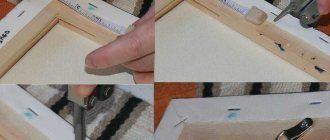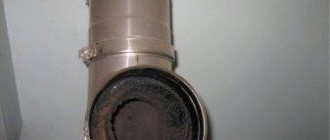People have been doing handicrafts for a long time. At first they made it for practical reasons - the crafts could be used in everyday life. Then man-made objects became a means of earning money. And now homemade things have aesthetic value. Handmade is valued all over the world today. In this article we will talk about how to make a pendant with your own hands.
Pendant with photo
An image of a loved one can support the wearer of such jewelry in difficult times and distract him from sad thoughts.
To make a pendant you will need:
- Two photographs.
- Unnecessary lighter.
- Glue "Moment".
- Scissors.
- Chain.
- Thin transparent plastic plate.
Step-by-step instructions on how to make a pendant with your own hands:
- Identical shapes are cut out from photographs.
- Parts of the same shape are cut out from a plastic plate.
- Each photograph is glued to a plastic part, and then the back parts are glued together.
- The edges of the resulting part along the perimeter are melted using a lighter. This operation requires special care and precision. Otherwise, the workpiece will be irreparably damaged.
- A chain is glued to the edges at the melting points around the perimeter. After this, you need to wait about 20 minutes for the glue to dry.
The pendant is worn on a chain or cord.
Coin rings or the path of an enthusiastic jeweler
Hello, people with hands from the right places and simply sympathetic. I'd like to tell you how I learned to make super cool coin rings. But no. Super-cool didn’t learn. In any case, I haven’t yet reached the level of “that’s it, now I can retire,” so let’s just call them ordinary coin rings.
Below the cut is a path through thorns, garage workshops and the suffering of numismatists.
It all started four years ago, when a post “how to do it easily and simply” began to actively circulate on VKontakte. There were 9 photographs, in two of which they hit a coin with an iron hammer, and then it was all so beautiful and unharmed. They used US quarters (25 cents) and I had a bunch of quarters on my desk from a recent trip. This is a sign, I thought, and forgot about this post for two months, leaving the quarters to gather dust.
According to the laws of the genre, this post came across my eyes quite regularly, so that at one moment I realized that I had not had any new hobby for a long time and wondered how it was actually done. I took a few five-ruble coins, a couple of cans of beer and went to the garage to experiment. Now I understand the importance of the accident that I came across coins before 2009, copper-nickel, and not modern steel.
A couple of hours of experiments showed that a garage of the “don’t throw anything away” type is good, but even this is not enough for comfortable work with unfamiliar material and requires a few specific tools. For example, cutting out disks, because when drilling with a drill, terrible sagging remained and the coin bent from heat and pressure. Or a jewelry bolt, which at first I tried to replace with some random, rusty, barely conical piece of iron. About six months remained before the video of lawyer Egorov appeared, where he turned a crossbar using a grinder from rebar in a lathe.
I googled YouTube, first ours, then a foreign one. I found out that a) no one does this in Russia, b) in the states it’s already commonplace and is in demand, c) almost no initial investment is required and everything is done quite simply (three times ha-ha). The only conclusion was made - we had to jump. I gutted my stash, went to Jewelry Tools, and left the stash. In fact, it only took about 5 thousand rubles for basic jewelry equipment (cutting tool, crossbar, plastic hammer). If I had ordered all this on Ali, it would have been much cheaper, but I needed it here and now. You know how it happens.
Well, then we know what: broken fingers, crooked rings, such and such a mother and the first “Oh, do the same for me!” This, of course, was the most pleasant thing. Because then the hobby gradually began to turn into work.
In fact, the manufacturing process itself is quite simple, although somewhat specific in terms of the tool used and more like instructions for a lathe. Everything seems clear, but it’s not clear.
Tools you will need:
Jewelry tool: — Cutting out disks, like this www.gemcuts.com.au/precision-disk-cutter-set-of-8-with-screw-down-lev You can use a drill, but it’s time-consuming and inconvenient. On Ali, of course, cutting is also available: www.aliexpress.com/premium/disc-cutters-for-jewelry.html?SearchText=disc+cutters+for+jewelry
— Rigel, this is such a metal cone, you can’t do without it, you can machine it from reinforcement like Advocate Egorov or again on Ali, you just need to make sure that it is steel (and not plastic) and smooth, without steps: www.aliexpress.com /wholesale?catId=0&SearchText=jewelry+mandrel
— Conventional tools: calipers, a vice (you can do without them, but it’s more convenient with them), a regular hammer, a plastic (or textolite) hammer, for saving the design on a coin, a 20 cm piece of PVC pipe (preferably of different internal diameters ± according to the size of the desired rings) , file, fine-grained sandpaper, polishing (goi paste, for example).
The algorithm is as follows:
— Find the center of the coin, cut a hole approximately 10 mm in diameter. Punching or drill
— We put the resulting washer on the crossbar and tap it with a plastic hammer so that the edges of the coin begin to bend down.
— Having bent the washer at least 45 degrees, we turn the bolt horizontally, resting the coin on some board. We continue to knock on the coin so that it continues to press against the bolt.
— Turn the coin over on the crossbar with the wide part facing up. We put a piece of plastic pipe on the crossbar, resting the end against the coin and knock with an ordinary hammer on the pipe from above, pushing the coin lower. The point is to remove the taper of the ring, making its walls parallel. We try not to overdo it with stretching, because... Without a jewelry anchor and a vice, you will not be able to reduce the size of the ring.
— We remove the ring, clean the edges with a file or coarse sandpaper, then fine sandpaper, then polish it.
Done, you are amazing! But I warned you that it looked like a lathe manual.
I used this algorithm to make rings for the first six months. Now the process has become much more complicated (but faster), and new tools have appeared in the equipment park, from a ring stretcher (Buratino) to special cones ordered from a turning workshop.
However, even then there was enough enthusiasm that even a friend’s broken finger did not prevent me from making it work. The plaster helped to hold the Dremel correctly.
About a year later, I finally learned how to work with silver. This was truly a great achievement, because before this, silver coins broke in about half the cases, which did not add optimism at all. It turned out that I simply annealed the silver incorrectly. That moment when a jewelry education WOULD be very useful, and Google actually came in handy. From the same series, the moment when I cooled a steel coin heated during annealing in water and could not understand why the hammer then crumbled on it. Literally, “How the steel was tempered.”
But, of course, we couldn’t do without a variety of first pancakes, and we still can’t do it to this day. The box with “Pinocchio curves” is regularly replenished, although at a slower rate than the “ready” box, which is good news.
I was working then, three years ago, with a friend in my garage. Naturally, there is a warehouse of junk there, like in any garage where the car is not parked. Well, a couple of free square meters for us. We don't need much. And one day they called and said, “We’re here from local television, we heard about you, we want to come to the workshop and film a report.” We were a little shocked, a little starstruck, and to celebrate, we said such nonsense on the entire TV that it’s still embarrassing to watch. And all this in a garage littered with rubbish.
Another time, a friend wrote to me “one day.” “I’m here,” he says, “I’m organizing a cosplay festival, let’s sell your rings there?” This is how the era of handmade markets opened for me. First locals in Yekaterinburg, then to neighboring regions. Last year I went to Moscow twice. We received you warmly, thank you.
With these markets, I had to again activate the “come up with something out of nothing” skill and create a stand. I didn’t want typical jewelry, I’m a creative person, so this miracle was born. Figure eight plexiglass, laser cutting of slots, end RGB tape and top lighting that has gone from “yes, it will do” to a 1600 lumen LED strip.
The year before last, due to circumstances, I had to leave my warm home garage and urgently find a replacement in a permanent garage. There my dream of a separate workbench came true. I extended the legs to an ordinary office table, pulled everything together with corners and firmly attached them to the floor and wall with corners and anchors. Of course, it’s not worth hitting it with a hammer, the tabletop vibrates from impacts, but the vice and pinocchio hold confidently, nothing moves anywhere and it’s generally pleasant.
Over time, I wanted more in making rings in the truest sense of the word. Large coins are always more attractive than small ones, and US craftsmen have long mastered them. Again, Google helped me find the terrible phrase swedish wrap method, which essentially means pressing the finished ring into a polished inner cone to reduce the size. Plumbing Teflon sealing tape came in very handy here to protect the design of the coin. And PVC pipes. And balls from bearings. And all sorts of other unknown crap that is beautifully laid out on the workbench in the previous photos. I'm telling you, it's a complicated method. But it turns out well.
So I got to, essentially, the icing on the cake. I went to her for a very long time - almost two years. The first idea to make a GIF of creating a ring from a Morgan dollar arose when I made the very first animation of copper pennies and immediately wanted to raise the bar. But then I still didn’t know how to work with silver. Then a second problem arose - the size of the coin. For the technologies existing at that time in my workshop, the coin was too large, 38 millimeters is no joke. But this was also decided (the largest coin I have worked with at the moment is the 1937 British crown, 38.6 mm). True, the gif was still far away. It’s one thing to learn how to make rings from such a coin, but another thing is to find the time, place and situation to film the creation process. I won’t describe typical everyday problems, everyone knows them, but they took a few more months.
But, like everything in the world, it finally happened. Three hours of production and filming, five hours of processing and creation, a total of 8 hours of work for a 15-second animation. Amazing efficiency. Tag sarcasm.
GIF under spoiler
Well, now I’ve been trying for days to save $460 for an auto-centering coin punch and remember descriptive geometry and reverse engineering skills.
Happy Monday everyone!
Clay pendant
One of the most popular materials for making beautiful handmade pendants is polymer clay.
To work you will need:
- Polymer clay of two sharply different colors.
- Metal tape (wire).
- Parts of different sizes are cylindrical in shape.
- Plastic rolling pin.
- Transparent acrylic varnish.
- Pin.
- Ceramic, glass or plastic board as a working surface.
- Protective gloves (optional).
Stages of work
- Bend the metal strip (wire) at the end to give it a spiral shape.
- Bend the other end of the ribbon using cylindrical pieces to give it a zigzag shape.
- The tape should be aligned so that, when placed on a flat surface, it is in the same plane.
- The clay must be kneaded, both pieces of different colors must be rolled out into sheets and folded.
- The blank is then rolled into a spiral so that the lighter color becomes dominant.
- The resulting part is bent several times and rolled out to a cylindrical state.
- The resulting cylinder is rolled out into a sheet.
- The wire element is carefully pressed into a flat clay sheet.
- Excess material is removed.
- A ball is molded from a piece of dark clay and fixed with a pin on the top of the main workpiece.
- Polymer clay is baked at the temperature indicated on its original packaging. After cooling, the workpiece is coated with a layer of varnish.
How much is a rare 10 rubles worth? 2010, series “Russian Federation” copies
Perm Territory, Chechen Republic, as well as the Yamalo-Nenets Autonomous Okrug
| Purchase price OT | |
| Chechen | 3000 |
| Yamalo-Nenets | 7500 |
| Permian | 2500 |
Price tag date 2021-10-15 Purchase price is indicated in rubles.
There are 3 copies valued on the market: Perm Territory (200,000), Chechen Republic (100,000), and Yamalo-Nenets Autonomous Okrug (100,000) . By the way, “Nenets Autonomous Okrug” was also released in the same year. All products are made as AC from brass/nickel silver and have a diameter of 27.0. Numismatic products from this series are not anniversary ones; all 3 were minted at SPMD. They differ in their reverses, which contain images of the coat of arms of administrative units. You can sell them to our store in Moscow at a competitive price.
Numismatics experts of the 1st category
Confidentiality and security of the transaction
Pendant made from scrap materials
What can you make an original pendant from? For example, from four pieces of felt of different colors, three multi-colored rectangles measuring 10x1.5 cm, and 9 pieces measuring 7x1 cm are cut out.
The cut parts are rolled up. Moreover, one tube is rolled out of three multi-colored rectangles.
Manufacturing process
During rolling, the felt is glued with textile glue, and after that the rolls are connected to form a flower. The ring for the chain is threaded through the petal by piercing it with an awl or a thick needle.
What else can be made from coins
There are many options for crafts made from pennies. The main thing here is to know how much you have, so that there is enough material to cover large surfaces. If there are few coins, then you can make a decoration. This could be a bracelet or a necklace.
The coins are attached to each other through holes into which a ring is threaded, which is sold in craft stores. Coins can be flattened with a hammer to erase the design on them. Then the necklace will look rich, but no one will guess that it is made from ordinary banknotes.
To make a bracelet for your arm or leg, you can take foreign coins. The product will be creative and original. Don't forget to sand the areas where the drill worked so that the metal does not prick the body.
Important! When working with money material, be sure to wash it in a soapy solution with a fine brush to wash away all the dirt that has accumulated between the letters and numbers over a long period of using money. This is especially true when producing crafts in which food will be stored.
If the product can be coated with craft varnish, then use it so that the coins do not oxidize and retain their shine for a long time. And be sure to try to make at least one craft from coins, because these products look creative and unusual.
Leather pendant
There are other options and ideas on how to make a pendant. To make a leather pendant, you will need four oval-shaped templates, which are cut out of cardboard. One of the oval templates should be larger than the others.
Then similar elements are cut out of the leather, but with an allowance of 1.5-2 mm for wrapping and gluing it to the back side of the katon template.
Sequence of work
Two oblong elements should be cut out of light-colored leather, and then glued together like cords. One cord should decorate the pendant, and the other should be a facet-cut stone or cabochon. Decorative details should be made from two pieces of leather of light and dark colors, having previously crumpled them. To do this, it is necessary to place crumpled leather blanks on a plastic film coated with glue to form folds on them.
The finished elements are placed on the main blank, small parts and crumpled pieces of leather are placed in free space and decorated with cords. You can hang the resulting pendant on a light leather cord with decorative knots.
Rare coins 10 rubles
How much does a 10 ruble coin cost? The price depends on many factors: rarity of copies, year of issue, condition (degree of wear). As a rule, the older the coin, the more expensive its value, provided, of course, that it is a commemorative, collectible piece. But it is not only rarities that are in great demand among collectors. Modern Russian coins with a face value of 10 rubles can also be quite valuable.
Ten-ruble coins of Russia from the 2000s.
A total of 146 commemorative and anniversary coins were issued in the period 2000-2016 in Russia. The rarest and most expensive of the 10 ruble coins are considered to be only three coins from 2010, namely:
- Valuable ruble coin Russia, Perm region;
- Valuable ruble coin Chechnya;
- Valuable ruble coin of the Yamalo-Nenets Autonomous Okrug.
2017 will be remembered for the release of 5 more commemorative 10 ruble coins, among which there will be those dedicated to the hero cities of Sevastopol and Kerch. In 2022, 4 types of coins will be launched, 2 of which are dedicated to the Winter Universiade in Krasnoyarsk, and the rest will be a continuation of the Ancient Cities and Regions of Russia series. The Bank of Russia has already announced the issue of commemorative, anniversary coins with a face value of 10 rubles in 2022, 2022.
The series “Ancient Cities of Russia” includes 39 coins:
- 3 coins each 2002, 2004, 2006, 2007, 2016,
- 4 - 2003, 2005, 2008, 2009
- 2 – 2010, 2011
- by 1 – 2012, 2014, 2022, 2022
The “Regions of the Russian Federation” series includes 45 coins, among them:
- valuable coin 10 rubles issued in 2005 - 6 pieces;
- valuable coin 10 rubles 2006 - 5 pcs.;
- valuable coin 10 rubles 2007 - 6 pcs.;
- expensive coin 10 rubles 2008 - 4 pcs.;
- expensive coin 10 rubles 2009 - 5 pcs.;
- valuable coin 2010 - 4 pieces;
- valuable coin 2011 - 2 pieces;
- valuable coin 2013 - 2 pcs.;
- valuable coin 2014 - 5 pcs.;
- valuable coin 2016 - 3 pieces;
- 2017 - 2 pieces;
- 2018 - 1 piece.
It is worth considering that coins with a denomination of 10 rubles, which do not have custom signs, abrasions, chips, stains, and with a bright stamp field, are much more expensive, more precisely by 30-100%. Also, the price depends on the year of manufacture; the closer to 2000, the higher the price. The reason for this is quite simple. In those days, all coins, without exception, including commemorative and anniversary coins, were in general use, so these specimens generally have clearly visible elements of wear.
The first bimetallic commemorative coin was issued in 2000 and dedicated to the 55th anniversary of the Victory. The 40th anniversary of Yuri Gagarin's flight was also commemorated with a 10 ruble coin in 2001.
Both coins were issued in a circulation of 20 million copies. Each of them was minted at the Moscow and St. Petersburg mints, 10 million pieces each. As a result, each coin came out with two monograms from different mints.
Commemorative coins, starting from 2000, had differences from their predecessors, namely: they became larger, the diameter increased by 2 mm, and the color scheme also changed, the center began to be made of a white copper-nickel alloy, the surrounding disk was made of brass.
At the Wolmar online auction you can buy rare 10 ruble coins.
Pre-Petrine coins at the current VIP auction with prices
Pre-1917 gold coins at current VIP auction with prices
Silver coins before 1917 at the current VIP auction with prices
Silver and others before 1800 at the current VIP auction with prices
Silver and others from 1800 to 1945 at the current VIP auction with prices
Silver and others after 1945 at the current VIP auction with prices
Copper coins before 1917 at the current VIP auction with prices
Wire pendant
A large number of master classes telling how to make a beautiful pendant from wire are posted on the world wide web. Among them are such popular products as “Dream Catcher” and “Tree of Life”.
The latter option allows you to show creative imagination and individuality in the bends, number and design of the branches of the “Tree”.
The meaning of an amulet in the form of a coin
The talisman cash coin is obviously designed to attract wealth. Among the most popular is the Tibetan amulet coin; many legends and traditions surround it. This amulet was brought to Russia by Peter I. It is believed that one of the monks gave him the talisman and spoke to him for success in government affairs. Since then, each representative of the Romanov dynasty has been charmed with their own coin so that it will protect them. During the revolution, when persecution of priests began, conspiracies and prayers were lost. It is unknown whether coins are spoken with the same words these days, but they believe in their power and carry them with them. Some are so lucky that they find a coin from those very times of Peter the Great. This can only be checked by specialists, beware of scammers!
Silver Money amulet (look in the SUNLIGHT catalogue)
The imperial coin (the Tibetan amulet coin also bears this name) usually has a hole in the center. An amulet coin for good luck and wealth can help if you are experiencing some kind of financial difficulties, for example, a breakdown in business or loss of a job. Esotericists especially advise those who are regularly plagued by failures to take a closer look at the talisman. Even if you simply do not feel the necessary efficiency and diligence (not because you are lazy, but because you are tired or you give up), an amulet coin for attracting money will remind you that you need to gather your strength and help you find it.
Everything doesn’t have to be bad in order to resort to the help of a talisman. It is enough just to desire wealth, put effort into it and believe that the amulet will help you. So the coin may help you negotiate with your boss about a salary increase or lead you to a large profitable project that you have long dreamed of. Some suspicious people who endow their talismans with amazing properties tell stories of how a simple coin with a hole in the middle helped them completely change their field of activity and thereby get rich. It’s not for nothing that they say that the craft and profession that you like brings in the most money
Pendant made from waste materials
Unnecessary keys and old coins can be used to make a pendant. To do this, an ordinary key is decorated with rhinestones, sequins or beads glued to it.
Coin pendant
Making this bat craft requires masculine strength. You will need a ten-ruble coin, which must be treated with abrasive paper. The hole for the ring is drilled with a small diameter drill.
The central part of the coin is removed with a hammer using a bearing. The image is applied to the central part of the coin, fixed in a vice, using needle files, a special jigsaw and a diamond bur.
After applying the image, the central part is installed with a hammer in its original place. The chain ring is threaded through the previously drilled hole and the pendant is ready for display.
Help with work
In case of difficulties in working on a craft, photos published on the Internet showing how to make a pendant at home can be of great help.
